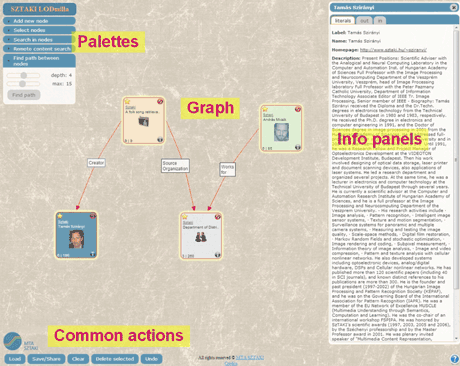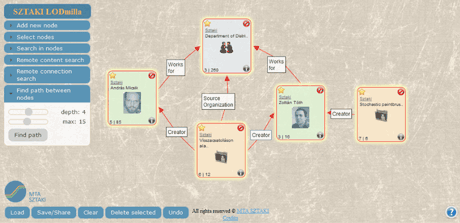by András Micsik, Sándor Turbucz and Zoltán Tóth
There are a range of problems associated with current Linked Data visualization tools, including lack of genericity and reliance on non-standard dataset endpoint features. These problems hinder the emergence of generic Linked Data browsers and can thus complicate the process of accessing Linked Data. With LODmilla we aim to overcome common problems of Linked Open data (LOD) browsing and to establish an extensible base platform for further evolution of Linked Data browsers.
The Linked Open Data (LOD) concept is based on the Linked Data principles set by Tim Berners-Lee in 2006 and the open data movement (formalized by the Open Definition). Semantic data is not only machine processable but it is often the primary source for information sought by humans. Recent years have seen the development of many useful semantic data visualizations prepared for insular purposes. There are also several generic approaches to present LOD for humans, such as Graphity, RelFinder and LodLive, which offer quite different solutions in terms of data presentation and navigation capabilities.
The situation can be compared to the WWW paradigm; roughly 20 years after the birth of WWW we have a broad consensus on how a web browser should work and what its common functions are. Recent developments show that a similar convergence has started in the realm of LOD browsing. The LODmilla browser is our attempt to advance this convergence.


LOD has a dual nature; it can be seen as a graph as well as a set of data tables or records, consequently a visualization is needed that combines these two features. In LODmilla, therefore, the entities are shown as graph nodes with predicates drawn as named edges among nodes (Figure 1). On the other hand, both datatype and object properties of the entities can also be looked over in a text list. Figure 1 shows the main parts of the LODmilla screen: the graph view takes the major part of the screen, while the information panel shows details about the selected node on the right side. The palettes on the right contain a customizable and extensible set of tools for navigation and graph expansion. The menu of common actions such as “undo” and “clear” is positioned at the bottom.
LODmilla provides some functionality in each of the following categories, which we identified as desirable functionality groups for LOD browsing:
- Graph management: e.g. open/close/ select nodes
- Graph view manipulation: zoom, pan, etc.
- Viewing properties: list/filter properties, open linked nodes, etc.
- Personal use: settings, undo, load/save graph views
- Collaboration: share graph view with others, comment
- Exploration: e.g. search the graph neighbourhood according to various criteria.
Some of the more interesting features of these functionality groups are highlighted below.
Specific screens can be saved by users and shared with other users via secret URLs. The recipient’s screen will show exactly the same graph as the one saved by the sender.
The core difficulty of browsing the LOD graph is the high number of nodes and edges. Providing access to all information but presenting only the selected pieces are key principles in this case. The performance of a graph action may squeeze hundreds of new nodes or connections on the screen. In this case the user can push the “undo” button to end confusion and revert to the previous view. It is also common for nodes to have hundreds of data properties, which is unmanageable in a traditional list. We provide grouping of properties by type and progressive search in the contents of data properties, in a similar manner to “Ctrl-F” in web browsers.
The most exciting aspect is the ability to expand the graph in intelligently selective ways: LODmilla has three experimental expansion functions implemented, and many more can be plugged in. First, a given type of link can be expanded starting from selected nodes. This will show, for example, the creator network surrounding a paper. Second, a text search can be run in neighbouring nodes, and nodes containing the text pattern will appear on the screen. The third option is path finding between nodes: the search starts from all selected nodes and runs until they link up or the maximum search depth is reached (see Figure 2 for an example, where new connections are drawn with red).
Finally, LODmilla aims to be usable with the broadest range of LOD datasets. For this, we avoid the need for per dataset configuration in the browser, and provide a browsing solution that works both via dereferencable URIs and SPARQL endpoints.
The LODmilla browser is open both to try out and to extend via the links below. Thus we hope to progress the community towards common understanding and implementation of intelligent human browsing for Linked Data.
Links:
LODmilla web application: http://munkapad.sztaki.hu/lodmilla
Source code: https://github.com/dsd-sztaki-hu/LODmilla-frontend
References:
[1] A. Micsik et al.: “LODmilla: shared visualization of Linked Open Data” in proc of First Workshop on Linking and Contextualizing Publications and Datasets, La Valletta, Malta, 2013
[2] A-S. Dadzie, M. Rowe: “Approaches to visualising linked data: a survey. Semantic web 2, 2 (April 2011), 89-124, dx.doi.org/10.3233/SW-2011-0037
Please contact:
András Micsik
SZTAKI, Hungary
Tel: +36 1 279 6248
E-mail:











